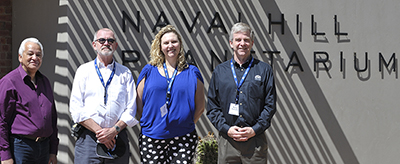
From the left are: Prof Neil Heideman
(Dean: Faculty of Natural and Agricultural Sciences, UFS),
Jack White (Director: Sky-Skan Oceania),
Dr Michelle Cluver (Department of Astronomy, University of the Western Cape),
Martin Ratcliffe (Director: Professional Development, Sky-Skan).
Photo: Mart-Mari Duvenhage |
South Africa hosts some of the world’s largest telescopes, and won the bid to co-host the SKA recently. So it’s not surprising that there is unprecedented interest in Astronomy in our country. Astronomy is seen as a gateway subject that attracts people to the sciences, while planetariums help to make Astronomy accessible to millions of people. Digital planetariums are especially powerful teaching tools because they are versatile, offer an immersive experience, and explain and illustrate three-dimensional concepts effectively. On the other hand, scientists, are eager to exploit a digital planetarium’s potential to represent and explore data visually, whether the data relate to medicine, astronomy, chemistry, the environment, or other fields of research.
The four-day ‘Digital Sky Academy’ (DSA) presented at the Naval Hill Planetarium in Bloemfontein from 18 - 22 September 2015 was an opportunity to offer training and first-hand experience of digital planetarium technology to representatives from other centres in South Africa. The Department of Physics at the University of the Free State (UFS) was the host of this event.
The Department of Science and Technology has designated the Naval Hill Planetarium as the South African hub for the training of digital planetarium presenters and operators. In addition to attracting interest from scientists and future planetarium operators and presenters, the DSA workshop provided an invaluable opportunity for our presenters to hone their skills.
A number of experienced and distinguished people attended the workshop. Among them was Dr Mark SubbaRao from Chicago in the United States, who shared information on data visualisation techniques used in the Adler Planetarium. Jack White, Director of Sky-Skan, one of the few companies that provide digital technology for planetariums throughout the world, coordinated the event in partnership with Prof Matie Hoffman from the Department of Physics at the UFS.
Jack travelled from Melbourne in Australia to oversee the workshop. Two Sky-Skan colleagues from the United States, Martin Weiss and Martin Ratcliffe, were on hand to share their expertise on digital planetarium hardware and software. The workshop programme included Skype conference calls with other US-based planetarium experts. Amongst the delegates to the DSA representatives from the SKA, the Iziko Museum, and five South Africa universities. They were here to gain experience, explore the capacity of the digital facility, and share ideas on future collaboration.
During the workshop, a public lecture was held on 19 September. Dr Michelle Cluver from the University of the Western Cape gave a presentation entitled, ‘More than the eye can see: the significance of infrared light in Astronomy.’